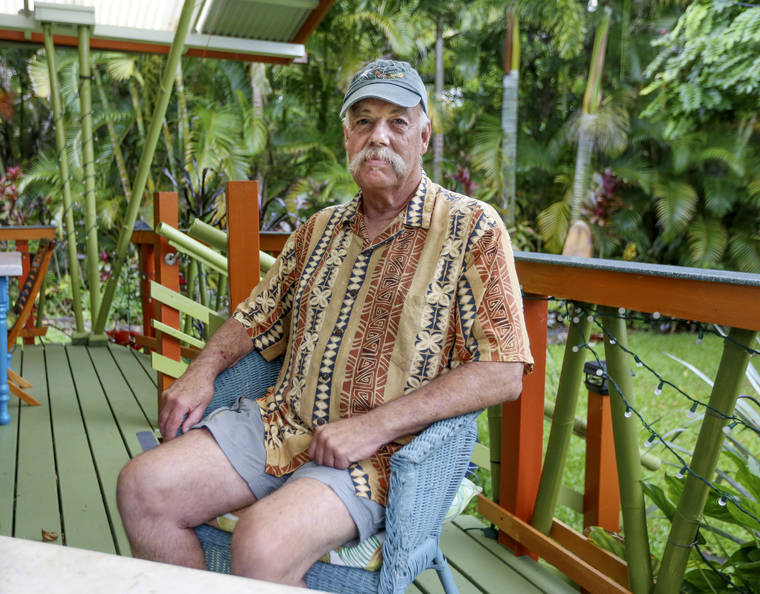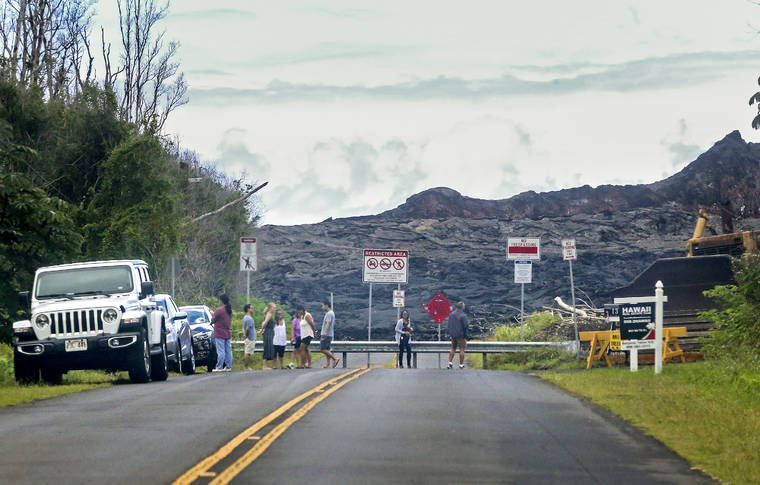HILO — Almost a year after the end of liquid lava in lower Puna, Leilani Estates continues to wrestle with packs of tourists attracted to the vestiges of last year’s Kilauea eruption.
Leilani Estates Community Association President Andy Andrews said the subdivision frequently sees vans of tourists traveling the streets to catch a glimpse of the cooled lava and the remains of fissure 8.
“Some (residents) aren’t bothered by it, but others are very bothered,” Andrews said, explaining that much of the antipathy to tourists stems from a sense that tourists are less interested in seeing lava than in seeing its effects on the still-recovering community.
“What we have in Leilani is a bunch of lava rock that looks suspiciously like the lava rock we have everywhere on the island,” Andrews said. “So it seems like there is something else here that people want to see.”
The influx of tourist groups has led to crowding on residential streets, with groups often parking on roads that even residents are not allowed to park on, and visitors often climb the lava flows to reach the top of fissure 8. And while Andrews said there haven’t been any “nasty confrontations,” he admitted that “shouting matches” have broken out between residents and tourists on occasion.
Andrews said the community association is exploring means of curbing tourist access to the subdivision, which lost scores of homes to the lava.
One such method of reducing access has been to apply barriers on certain subdivision roads labeled with signs restricting access to residents only. While Andrews said these appear effective at deterring visitors who are traveling on their own, larger tour groups have long since realized that the barriers “have no teeth” and can be easily circumvented.
Late last year, the previous president of the community association had started discussions regarding making Leilani Avenue — now one of only two roads into the subdivision — into a private road, controlling access with a gate. However, while Andrews said that plan is still being discussed, cost estimates of the plan suggest that it would cost $60,000 at absolute minimum, and would likely rise to more than $100,000 before the end of the project.
Although Andrews said he would investigate better ways to spend that money, he added that there are still some residents who are strongly in support of the gate.
“A lot of the upset is because the tourists are co-mingling with those with evil intentions,” Andrews said. “People coming in to rip off houses, and squatters.”
Other residents, however, see the gate as a needless extravagance. Resident Cheryl Carroll said the tourism issue only impacts residents who live close to the lava. While she said the tourists cause real problems for those residents, they could easily be mitigated by a coherent tourism plan by the community association.
Andrews said a committee will decide on future plans to resolve tourism, including potentially soliciting lawmakers for federal funds, or contacting tourism-focused businesses to encourage visitors to find other places to observe the lava. But Carroll suggested that working with the county and tour companies would be preferable, as it would allow the community to remain open to the island at large.
“There’s a conflict here between the mainland concept of property’s monetary value and the ohana,” Carroll said.
While the flow of tourists is unlikely to end soon, Andrews said he has asked tourists to make an effort to view the lava not as an abstract geological event, but as an event that had a very real cost to hundreds of residents. To their credit, he said, many tourists seem to take that perspective to heart.
“I used to tell people I was from Hawaii Island, which gets them to ask, ‘Oh, that’s where Honolulu is, right?’ and then there’s that impromptu geography lesson,” Andrews said. “But now I can say I’m from Leilani Estates, and they know exactly what that means.”
Email Michael Brestovansky at mbrestovansky@hawaiitribune-herald.com.




